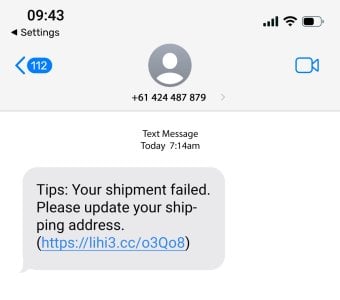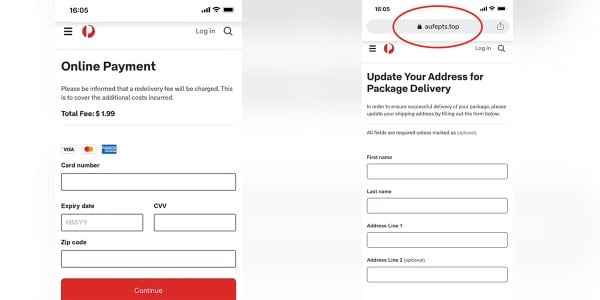Can you outsmart this nearly undetectable Australia Post scam? Online shopper gives urgent advice
By
VanessaC
- Replies 30
It sounds like the ideal situation–you’ve ordered a gift for yourself, and eagerly await its arrival. But then you get a text or email that the shipment failed. All you need to do is click on the link and update the shipping address.
It sounds innocent, but this simple message is a newly developed scam that has caused chaos in the lives of Australians across the country.
A woman from Sydney opened up about her close call and shared the message she received, which had cleverly been made to look like it was from Australia Post. Fortunately, she was able to spot the scam before it was too late–and now she’s hoping others won’t make the same mistake.
The message read: 'Tips: Your shipment failed. Please update your shipping address.'
It included a link which, when clicked, directed the woman to a website that contained an address form–and, if completed, would have requested her credit card details for a 'redelivery fee'.
Luckily, the woman realised something was wrong when her package unexpectedly turned up.
'I was shocked at how real the text message was… and I also find it terrifying these scammers know exactly when you are about to receive a package,' she said.
But how can you spot the scam when it’s so well disguised? Here’s what to look out for:
A spokeswoman from Australia Post reminded everyone that they never contact customers via email, SMS, or phone asking for payments or personal and financial information.
'We also encourage customers to download the Australia Post app, which is the most reliable and secure way to receive delivery updates because it uses push notifications that can’t be replicated by scammers,' she added.
Here are some steps to take if you suspect you've been scammed:
If you find yourself in a position where you've received an alert from what appears to be Australia Post that ticks all the boxes of this new scam, remain calm, but take immediate action.
First, avoid clicking the link to provide any personal or financial information. The cold anonymity of online interaction can easily lend itself to panic, especially when one thinks a much-anticipated parcel is in jeopardy. But remember that Australia Post will never ask for these details through text or email.
Second, report the matter directly to Australia Post. You can reach them by email at [email protected]. Provide as much information as possible about the scam to aid their investigations. Any screen grabs, or detailed conversation descriptions can go a long way in busting these operations.
Following that, delete the message. Make sure it's completely removed from whatever device you received it on–your mobile phone, tablet, or home computer.
If you've unfortunately fallen for the scam and provided personal or financial information, contact your bank or financial institution as soon as possible. They are well versed in these types of situations and can give advice and in some instances, can stop a transaction from going through or close your compromised accounts.
And finally, let others know about your experience. Share what happened with your circle of friends and relatives to prevent them from falling victim to the same trickery.
Scammers are constantly evolving their methods, making it crucial for everyone to stay one step ahead. You can do this by regularly checking our ScamWatch forum for news or information on the latest scams.
You can also visit Australian Competition and Consumer Commission’s Scamwatch website, which has information and advice for consumers when shopping online, as well as tips to help you identify if a website is fake.
Help spread the word by sharing this article with your family and friends!

Have you or anyone you know been taken advantage of by one of these scams? Share your experience with us in the comments below.
It sounds innocent, but this simple message is a newly developed scam that has caused chaos in the lives of Australians across the country.
A woman from Sydney opened up about her close call and shared the message she received, which had cleverly been made to look like it was from Australia Post. Fortunately, she was able to spot the scam before it was too late–and now she’s hoping others won’t make the same mistake.
The message read: 'Tips: Your shipment failed. Please update your shipping address.'
It included a link which, when clicked, directed the woman to a website that contained an address form–and, if completed, would have requested her credit card details for a 'redelivery fee'.
Luckily, the woman realised something was wrong when her package unexpectedly turned up.
'I was shocked at how real the text message was… and I also find it terrifying these scammers know exactly when you are about to receive a package,' she said.
But how can you spot the scam when it’s so well disguised? Here’s what to look out for:
- A text message or email that looks to have been sent from Australia Post, asking you to click a link.
- Unusual sense of urgency.
- The website you’re directed to contains a non-Australia Post web address. (This is Australia Post’s legitimate web address: https://auspost.com.au/)
A spokeswoman from Australia Post reminded everyone that they never contact customers via email, SMS, or phone asking for payments or personal and financial information.
'We also encourage customers to download the Australia Post app, which is the most reliable and secure way to receive delivery updates because it uses push notifications that can’t be replicated by scammers,' she added.
Here are some steps to take if you suspect you've been scammed:
If you find yourself in a position where you've received an alert from what appears to be Australia Post that ticks all the boxes of this new scam, remain calm, but take immediate action.
First, avoid clicking the link to provide any personal or financial information. The cold anonymity of online interaction can easily lend itself to panic, especially when one thinks a much-anticipated parcel is in jeopardy. But remember that Australia Post will never ask for these details through text or email.
Second, report the matter directly to Australia Post. You can reach them by email at [email protected]. Provide as much information as possible about the scam to aid their investigations. Any screen grabs, or detailed conversation descriptions can go a long way in busting these operations.
Following that, delete the message. Make sure it's completely removed from whatever device you received it on–your mobile phone, tablet, or home computer.
If you've unfortunately fallen for the scam and provided personal or financial information, contact your bank or financial institution as soon as possible. They are well versed in these types of situations and can give advice and in some instances, can stop a transaction from going through or close your compromised accounts.
And finally, let others know about your experience. Share what happened with your circle of friends and relatives to prevent them from falling victim to the same trickery.
Scammers are constantly evolving their methods, making it crucial for everyone to stay one step ahead. You can do this by regularly checking our ScamWatch forum for news or information on the latest scams.
You can also visit Australian Competition and Consumer Commission’s Scamwatch website, which has information and advice for consumers when shopping online, as well as tips to help you identify if a website is fake.
Help spread the word by sharing this article with your family and friends!
Key Takeaways
- A Sydney woman almost fell for an Australia Post text message scam.
- The scam involved a text message claiming that her package delivery had failed, then directed her to a website that looked like the legitimate Australia Post website.
- Australia Post has reminded customers that they never request payments or personal and financial information via text or email.
- Customers who receive suspicious messages appearing to be from Australia Post are urged to report it to [email protected] and to delete the message immediately.
Last edited:









